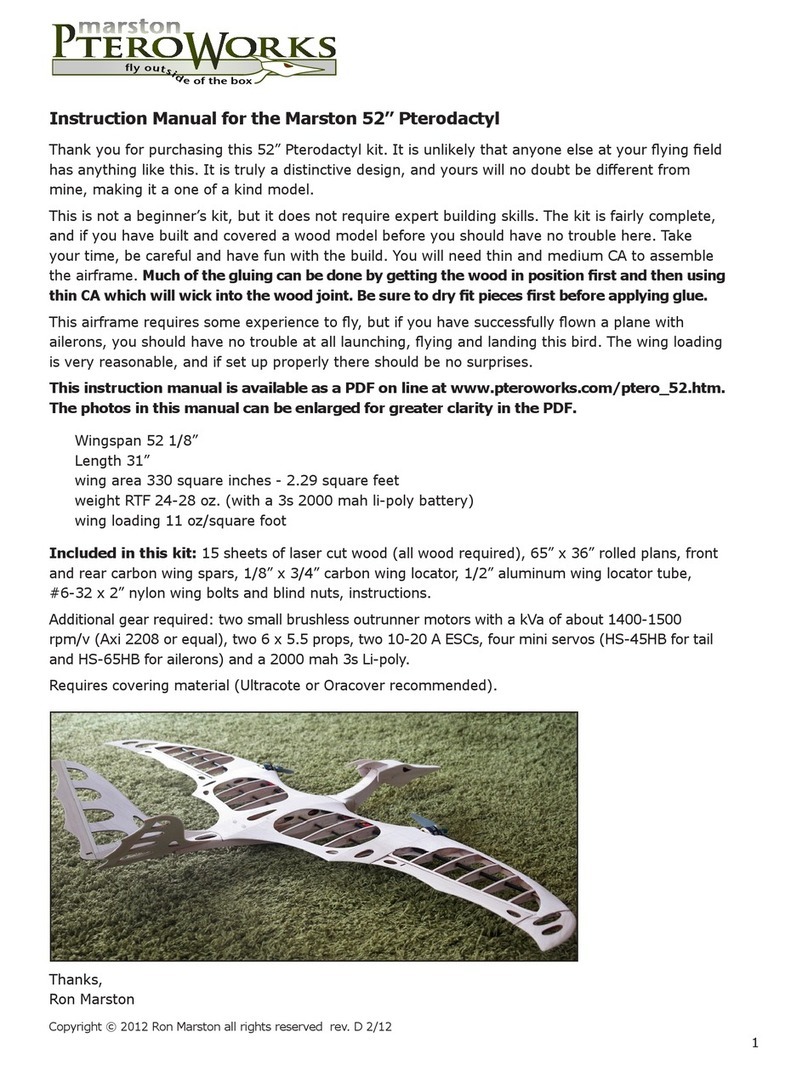
rev 10/09/07
Building Instructions for the 80” Marston Pterodactyl
Wing
1. Prepare spars - 3/8 x 1/8 x 36” spruce
Cut to length per plans. Glue .007 carbon strips to one side of inner pieces for added strength using CA or
epoxy (highly recommended)
2. Prepare brass wing joiner tubes - Use 13/32” x 5 1/2” for main joiner rod (3/8” x 10 1/2” carbon rod)
Use 5/32” x 1 9/16” for small locator rod 1/8” x 3” carbon rod)
3. Glue wing leading edge halves together with motor mount doublers using epoxy.
4. Glue reinforcing doublers to ribs 1, 2, 3, 4. (see picture 2 on website)
5. Assemble ribs 1 - 4, brass wing joiner tubes, leading edge, and bottom inner spar, on the plans
(notes: Do NOT epoxy brass wing joiner tubes until alignment can be checked with both wing halves. Rib 1 has
a twin brother that has no cutouts for the spars. This should be glued to the other rib 1 after wing assembly to
ensure a clean face the mating surfaces of the wing halves.) (see pictures 2 and 3 on website)
6. Assemble ribs 5 - 8 to lower spar and leading edge. (see pictures 4 and 5 on website)
7. Glue in top inner spar (carbon facing out.)
8. Thread a 1/8” x 1/4” spruce aft spar through ribs 1 - 8 and glue in place. (this is the curved one.)
9. Check alignment of right and left wing halves at this point, and epoxy all 4 brass wing joiner tubes.
Glue scrap balsa “plugs” at the inside ends of wing joiners. (see pictures 7 and 8 on website)
10. Glue bottom ply trailing edge to the assembled ribs (1 - 8). Don’t remove alignment tabs from the ribs yet. (see
picture 8 on website)
11. Sand faces of root rib (rib 1) and check surface mating with spars in place. Glue rib 1 doublers in place and
sand as necessary for a gap-less t between wing halves.
12. Place wing halves back on plans and epoxy lower outer spar in place, using a piece of scrap 1/16” ply as a
doubler, for added strength.
13. Assemble ribs 9 - 19 to bottom spar, leading edge, and trailing spar (1/8’ x 1/4” spruce) on plans.
(note: ribs have removable standoffs on their bottom trailing edge to help you build the wing true. Washout is
built into the standoffs.)
14. Glue upper outer spar in place.
15. Glue wing tip pieces together (you should have 4 wing tips - glue 2 together for each wing half). Use scrap
balsa to build up thickness of wing tip where it mates with rib 19. Sand to match airfoil. Wing tips should have a
slight (5 degree) upward angle.
16. Glue wing tips to wing.
17. Assemble ailerons (ply on bottom, balsa on top. (see picture 17 on website)
18. Assemble aps as per ailerons. (see picture 16 on website)
19. Cut and glue sheer webs to both sides of inner spars, and trailing edge of outer spars. Use 1/16” balsa with
VERTICAL grain direction (up and down). This is a tedious step, but it will dramatically increase the strength of the
wing.
20. Epoxy 1/8” carbon rods on the leading edge of both wing halves, about 1/4” from rib 1, pointing forward,
extending about 3/8” -1/2” beyond leading edge. These are the wing locator pins for attachment to the body
(fuselage). Surround with 1/8” scrap ply, and build up with scrap balsa as needed. (see pictures 12 and 13 on
website)
21. Build a “cradle” for your motors out of scrap 1/4” balsa (see picture 14 on website)
22. Sheet upper leading edges with 1/16” balsa. Use plans to trace shape to be cut. Cut about 1/4” oversized.
Soak balsa in water for 20-30 minutes rst to get it pliable. Use the lightest balsa you have (hold it up to the light
and see how transparent it is. Less density means more light will show through, which is good for this sheeting
job.) There are some tricky compound curves to deal with here, but it can be done if you are careful!
23. Install servos, motors, and speed controls, before sheeting the bottom of the wing.
24. Sheet bottom of wing leading edge. Shape is same as top sheeting. Cut hole between rib 1 and 2 for wires.






















